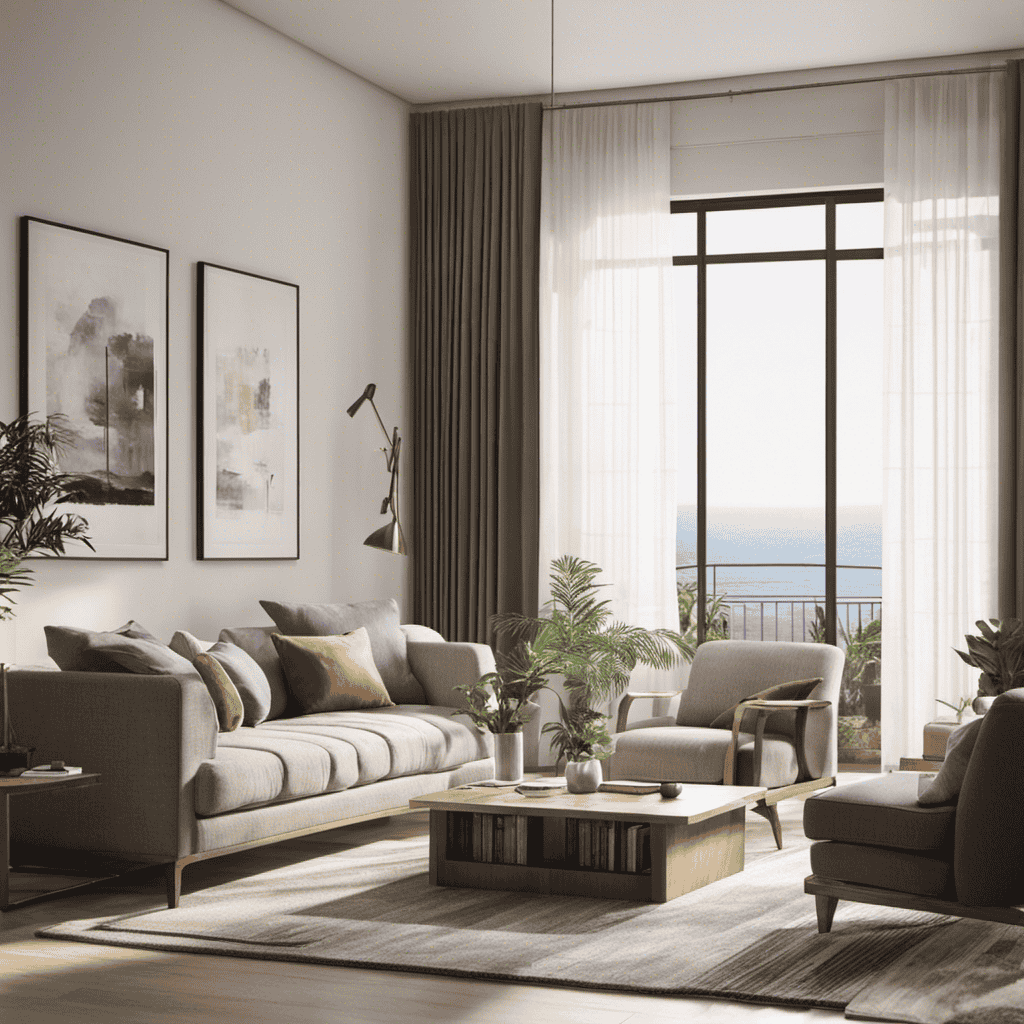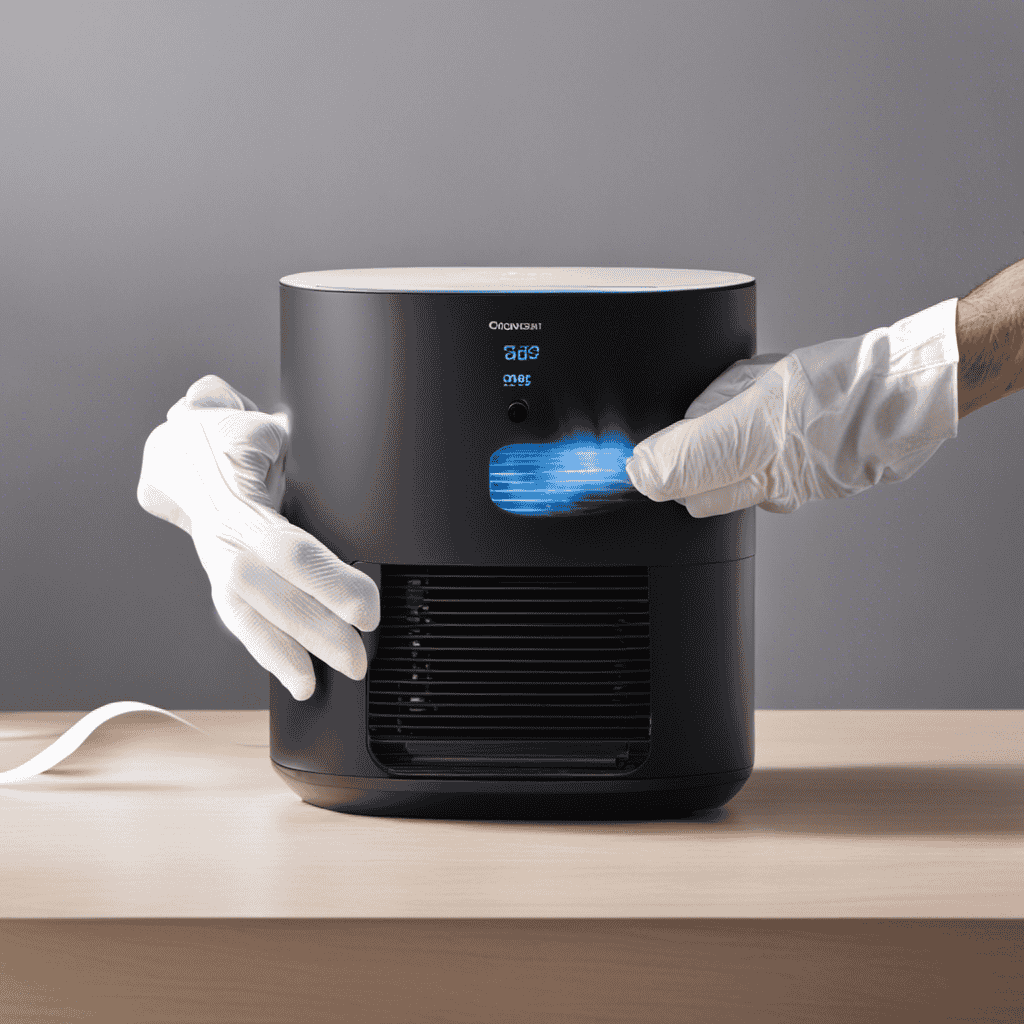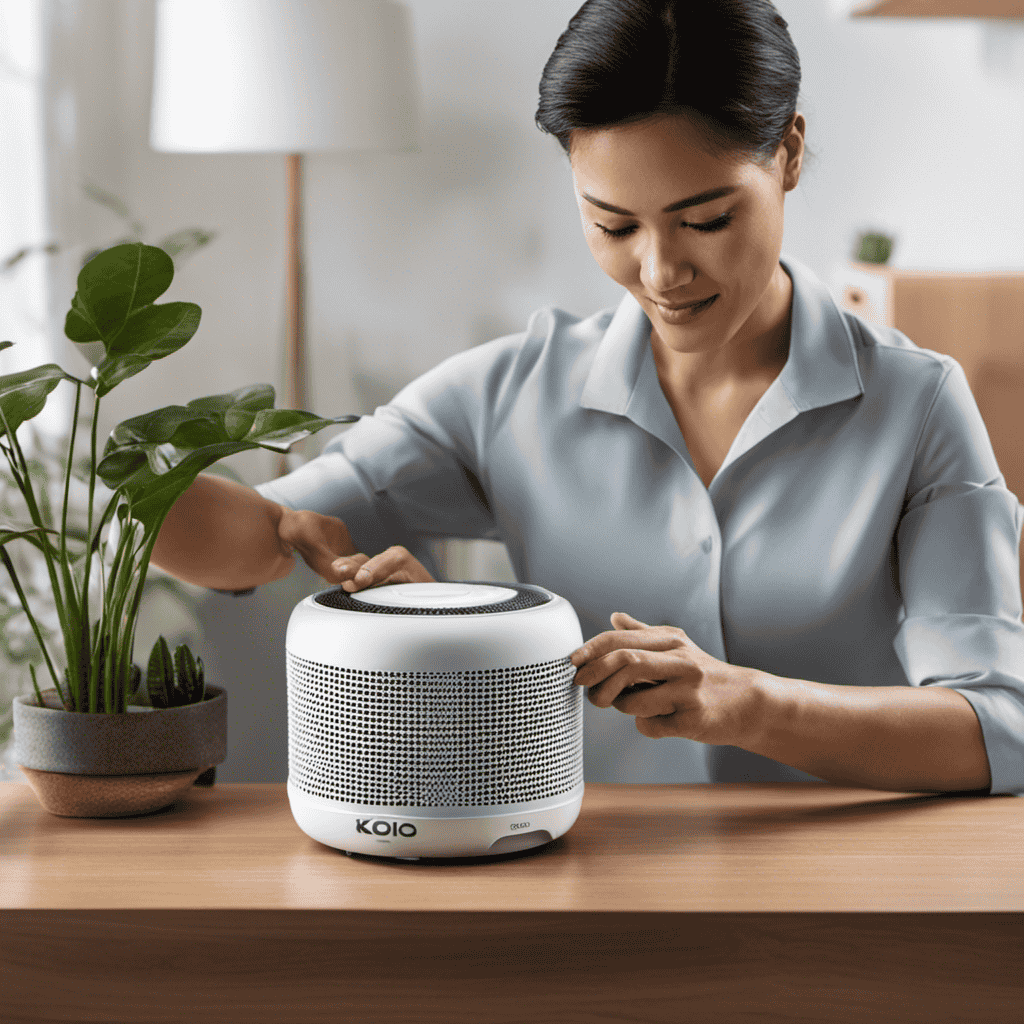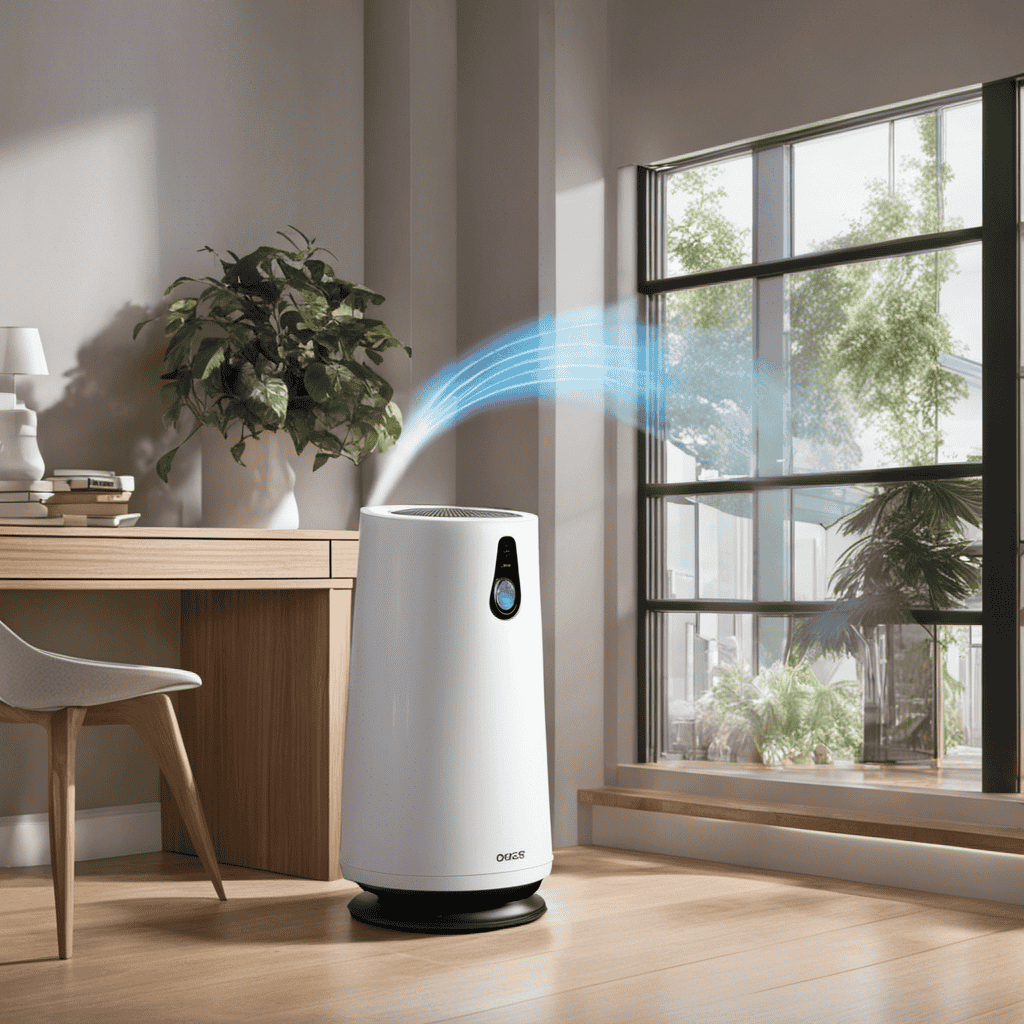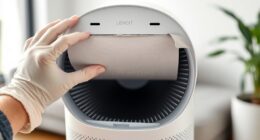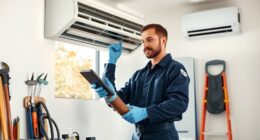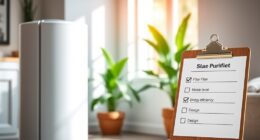As someone passionate about air purifiers, I constantly seek methods to enhance the quality of air indoors. A common inquiry is about the efficiency of air purifiers when the air conditioning is active. This is a significant issue, given our dependence on air conditioning to maintain comfort and coolness.
In this article, we will explore the benefits of using an air purifier alongside your AC, factors to consider when choosing the right purifier, and the science behind their effectiveness. So, let’s dive in and discover the truth behind this common misconception.
Key Takeaways
- Using an air purifier with the AC running improves air quality in your home by removing contaminants such as dust, allergens, and pollutants.
- Choosing an air purifier with a high Clean Air Delivery Rate (CADR) and suitable coverage area is important for optimal performance.
- HEPA filters are recommended for effective filtration and removal of harmful particles.
- The combined usage of an air purifier and AC maximizes benefits, enhances overall indoor air quality, and creates a more comfortable living space.
Benefits of Using an Air Purifier With the AC Running
Using an air purifier with the AC running can significantly improve the air quality in your home. Air purifiers are designed to remove contaminants from the air, such as dust, allergens, and pollutants. By running an air purifier alongside your AC system, you can effectively improve ventilation and reduce allergies.
Air purifiers work by capturing airborne particles through a combination of filters, such as HEPA filters, which can trap particles as small as 0.3 microns. This helps to remove pollen, pet dander, and other allergens that can trigger allergies. Additionally, air purifiers can also help to reduce odors and eliminate harmful substances, such as volatile organic compounds (VOCs) and bacteria.
Overall, using an air purifier with the AC running can create a healthier and more comfortable indoor environment for you and your family.
FACtors to Consider When Choosing an Air Purifier for Use With the AC
When choosing an air purifier to run alongside your AC, there are several factors you should consider.
First and foremost, you need to check the air purifier’s Clean Air Delivery Rate (CADR). This rating indicates the volume of clean air that the purifier can deliver per minute. A higher CADR means the purifier can effectively remove more pollutants from the air.
Additionally, consider the size of the room you want to purify. The air purifier should have a suitable coverage area to effectively clean the air in your space.
Lastly, pay attention to the type of filtration technology used in the purifier. HEPA filters are highly recommended as they can capture small particles, allergens, and even some viruses.
How an Air Purifier Can Improve Indoor Air Quality With the AC on
When it comes to improving indoor air quality, the synergy between an air conditioner (AC) and an air purifier is worth exploring.
The combined usage of these two devices offers numerous benefits such as enhanced filtration and removal of airborne pollutants.
AC and Air Purifier Synergy
The AC and air purifier work well together to improve indoor air quality. When used in conjunction, they can effectively remove pollutants such as dust, pollen, pet dander, and mold spores from the air. This synergistic effect ensures that the air you breathe is clean and fresh. Additionally, using an air purifier with the AC running can be cost-effective in the long run. While the initial investment may seem high, the benefits outweigh the costs. Not only does the air purifier enhance the performance of the AC by filtering out smaller particles, but it also reduces the strain on the AC system, leading to improved energy efficiency and potentially lower utility bills. Here is a table that illustrates the effectiveness and cost-effectiveness of using an air purifier with the AC:
| Effectiveness | Cost-effectiveness |
|---|---|
| Removes pollutants | Saves on energy bills |
| Enhances AC performance | Reduces strain on AC system |
| Improves indoor air quality | Long-term investment |
Benefits of Combined Usage
To maximize the benefits and save money, you should consider using an air purifier with your AC. Combining the two can greatly improve respiratory health by reducing allergens and pollutants in the air.
Air purifiers are designed to filter out harmful particles, such as dust, pollen, pet dander, and mold spores. When used in conjunction with your AC, they work together to create a cleaner and healthier indoor environment.
The AC helps circulate the air while the air purifier filters out the impurities, ensuring that you breathe in clean and fresh air. By reducing allergens and pollutants, this combination can alleviate symptoms of allergies and asthma, promoting better respiratory health.
With cleaner air, you can enhance your overall indoor air quality and create a more comfortable living space.
Enhancing Indoor Air Quality
You can improve your indoor air quality by using an air purifier in conjunction with your AC. Air purifiers are highly effective in removing harmful pollutants, allergens, and particles from the air.
Regular maintenance of your air purifier is essential to ensure its optimal performance. This includes cleaning or replacing the filters, checking the fan and motor, and keeping the unit free from dust and debris. By properly maintaining your air purifier, you can extend its lifespan and ensure it continues to effectively purify the air in your home.
Additionally, air purifiers are cost-effective in the long run. While there may be an initial investment, the benefits of improved indoor air quality and potential health benefits outweigh the cost.
Moreover, air purifiers can help reduce the need for frequent cleaning and maintenance of your AC system, saving you money in the long term.
The Science Behind the Effectiveness of Air Purifiers With the AC Running
When the AC is running, an air purifier can still be effective in improving air quality. Here’s why:
-
Enhanced Filtration: Air purifiers are designed to capture and remove airborne particles such as dust, pollen, pet dander, and mold spores. They use advanced filtration systems that can trap even the smallest particles, providing cleaner air for your space.
-
Complementary Function: While an AC focuses on cooling and controlling temperature, an air purifier targets air pollutants. By using both devices simultaneously, you can enjoy the benefits of clean and cool air.
-
Reduction of Allergens: Air purifiers help reduce common allergens in the air, making it easier for individuals with allergies or respiratory conditions to breathe comfortably. This is particularly important when the AC is running, as it may circulate allergens throughout the space.
Common Misconceptions About Air Purifiers With the AC on
One common misconception is that air purifiers are not necessary when the AC is on, but this is not true. While it is true that the AC system filters some particles from the air, it is not designed to fully purify the air.
Air purifiers have their own set of filters that are specifically designed to capture a wide range of pollutants, including dust, pollen, pet dander, and even volatile organic compounds (VOCs).
By using both the AC and an air purifier together, you can create a more comprehensive indoor air quality solution. However, it is important to note that there are potential drawbacks to running an air purifier with the AC, such as increased energy consumption.
To optimize the performance of an air purifier with the AC running, there are a few tips to keep in mind.
Tips for Optimizing the Performance of an Air Purifier With the AC Running
When it comes to using an air purifier with your AC, compatibility is key. Understanding how well your air purifier works with your AC system can greatly enhance the overall efficiency of air purification in your home.
In this discussion, we will explore the importance of AC and air purifier compatibility, as well as provide tips on how to optimize the performance of your air purifier when the AC is running.
AC and Air Purifier Compatibility
If you’re using an air purifier with the AC running, you’ll want to ensure that they are compatible. Here are a few important things to consider:
-
Air purifier maintenance: Regularly clean and replace the filters in your air purifier to ensure optimal performance. Clogged filters can strain the unit and reduce its effectiveness in removing pollutants from the air. This will also help prevent any potential damage to the air purifier itself.
-
Impact on energy consumption: Air purifiers require electricity to operate, and running them simultaneously with the AC can increase overall energy consumption. Consider using energy-efficient models and adjusting the settings of both devices to minimize energy usage without compromising air quality.
-
Placement and ventilation: Proper placement of the air purifier and AC unit is crucial. Ensure that the air purifier has adequate space around it for proper airflow. Additionally, proper ventilation in the room will help maintain good air quality and prevent the accumulation of pollutants.
Enhancing Air Purification Efficiency
To enhance the efficiency of your air purification system, consider using a HEPA filter in conjunction with regular cleaning and maintenance. A HEPA (High Efficiency Particulate Air) filter is designed to capture microscopic particles such as dust, pollen, and pet dander, improving the overall air quality in your space. Regular cleaning and maintenance are essential to ensure optimal performance and longevity of your air purifier.
Here is a table highlighting the recommended maintenance tasks for air purifiers and their frequency:
| Maintenance Task | Frequency |
|---|---|
| Filter Replacement | Every 6-12 months |
| Cleaning the Exterior | Monthly |
| Cleaning the Fan | Every 3 months |
| Cleaning the Sensor | Every 3 months |
| Checking for Leaks | Annually |
Proper maintenance not only enhances the efficiency of your air purifier but also extends its lifespan. It is important to note that regular maintenance can also help reduce energy consumption, as a well-maintained air purifier operates more efficiently. So, don’t forget to schedule regular cleaning and filter replacements to keep your air purification system running at its best.
Real-Life Experiences: Users Share Their Success Stories With Air Purifiers and AC
Users have shared their success stories with air purifiers and AC, saying that they’ve noticed a significant improvement in air quality. Here are the key takeaways from their testimonials:
-
Relief from Allergies: Many users have reported a reduction in allergy symptoms after using air purifiers in conjunction with their AC. The combination of these two devices helps to filter out allergens such as pollen, dust mites, and pet dander, providing relief for those who suffer from allergies.
-
Improved Sleep: Several users have mentioned that having an air purifier with their AC has improved their sleep quality. By removing pollutants and irritants from the air, it creates a cleaner and more comfortable sleeping environment.
-
Enhanced Overall Well-Being: Users have experienced an overall improvement in their well-being, citing fewer respiratory issues and a general feeling of freshness in their homes. The combination of air purifiers and AC helps to maintain optimal indoor air quality, which is essential for a healthy living environment.
Based on these testimonials, it is clear that using an air purifier with AC can have a positive impact on allergies and overall air quality.
Frequently Asked Questions
Can I Use Any Air Purifier With My Ac?
Yes, you can use any air purifier with your AC. Air purifiers are effective in removing pollutants and allergens from the air, providing several benefits when used in conjunction with the AC.
How Often Do I Need to ReplACe the Filters in an Air Purifier When Using It With the AC Running?
When using an air purifier with the AC running, it is important to consider the frequency of filter replacements. Regularly replacing filters ensures optimal performance and improves indoor air quality.
Are There Any Side Effects or Health Risks Associated With Using an Air Purifier With the AC On?
Using an air purifier with the AC running can help reduce side effects and allergies associated with poor air quality. It filters out pollutants and allergens, improving indoor air quality.
Will Using an Air Purifier With the AC Running Increase My Electricity Bill?
Using an air purifier with the AC running may lead to increased energy consumption, resulting in higher electricity bills. However, it can improve the effectiveness of air purification by filtering out pollutants and allergens.
Can an Air Purifier Remove Odors From the Air When the AC Is Running?
When the AC is running, an air purifier can effectively remove pet dander from the air. However, having an air purifier with a built-in ionizer is not necessary for it to be effective.
Conclusion
In conclusion, the combination of an air purifier with the AC running can greatly enhance indoor air quality. By effectively removing pollutants and allergens, these devices create a fresher and healthier environment.
However, it is important to choose the right air purifier that suits your needs and consider factors such as filter type and CADR ratings. While some misconceptions exist, scientific evidence supports the effectiveness of air purifiers with the AC on.
By following tips for optimization, users can maximize the benefits and achieve cleaner air. Real-life experiences further attest to the success of this powerful duo.



